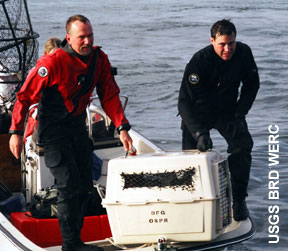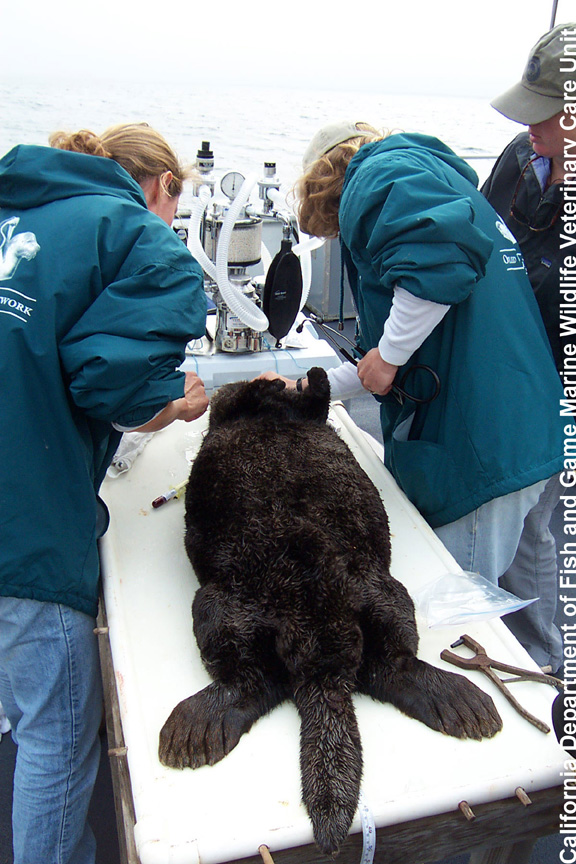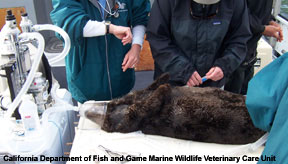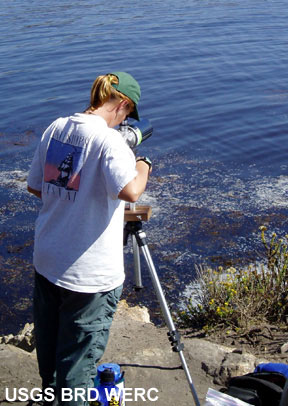|
POPULATION DYNAMICS
AND BIOLOGY OF THE
CALIFORNIA SEA
OTTER AT THE SOUTHERN END OF ITS RANGE
Principal Investigators: James Estes
(UCSC),
Terrie Williams (UCSC), Daniel Costa (UCSC),
Katherine Ralls (Smithsonian Institution), and Donald Siniff
(University of Minnesota)
Background
 Sea otters (Enhydra lutris) were hunted to near extinction
during the Pacific maritime fur trade (Kenyon 1969). Further
hunting was prohibited by international treaty in 1911, at which
time a dozen or so remnant colonies survived. The southern sea
otter (Enhydra lutris nereis) is descended from one of these
remnant colonies that survived along the Big Sur coastline of
central California, and contained perhaps as few as 50 individuals
at the beginning of the 20th century (Riedman and Estes 1990).
While sea otter populations elsewhere in the North Pacific Ocean
recovered at rates of 17-20% yr-1, the California pop Sea otters (Enhydra lutris) were hunted to near extinction
during the Pacific maritime fur trade (Kenyon 1969). Further
hunting was prohibited by international treaty in 1911, at which
time a dozen or so remnant colonies survived. The southern sea
otter (Enhydra lutris nereis) is descended from one of these
remnant colonies that survived along the Big Sur coastline of
central California, and contained perhaps as few as 50 individuals
at the beginning of the 20th century (Riedman and Estes 1990).
While sea otter populations elsewhere in the North Pacific Ocean
recovered at rates of 17-20% yr-1, the California pop ulation has never grown at more than
one-third this rate (Estes 1990) and is currently listed
as Threatened under the Endangered Species Act.
Concerns over oil and gas development were the principal reason for
listing, and the Southern Sea Otter Recovery
Team (SSORT) has based its recommended criteria for de-listing or
up-listing (to Endangered) on oil spill risk analysis (FWS 2000).
Our current understanding of the dynamics of the southern sea otter
population is largely based on MMS-funded studies conducted during
the 1980s (Siniff and Ralls, 1988), at a time when the population
was increasing. The population continued increasing until the
mid-1990s, at which time the U.S. Fish and Wildlife Service
anticipated de-listing by 2000. About 1995, however, the
population dynamics changed for unknown reasons and the population
began to decline; annual population counts have steadily decreased
since 1995 (USGS-BRD, unpublished data). At the present rate
of decline, the population will reach the SSORT's recommended
criterion for up-listing to Endangered within two to three years. ulation has never grown at more than
one-third this rate (Estes 1990) and is currently listed
as Threatened under the Endangered Species Act.
Concerns over oil and gas development were the principal reason for
listing, and the Southern Sea Otter Recovery
Team (SSORT) has based its recommended criteria for de-listing or
up-listing (to Endangered) on oil spill risk analysis (FWS 2000).
Our current understanding of the dynamics of the southern sea otter
population is largely based on MMS-funded studies conducted during
the 1980s (Siniff and Ralls, 1988), at a time when the population
was increasing. The population continued increasing until the
mid-1990s, at which time the U.S. Fish and Wildlife Service
anticipated de-listing by 2000. About 1995, however, the
population dynamics changed for unknown reasons and the population
began to decline; annual population counts have steadily decreased
since 1995 (USGS-BRD, unpublished data). At the present rate
of decline, the population will reach the SSORT's recommended
criterion for up-listing to Endangered within two to three years.
Although the California sea otter population is
declining, the geographic range of the population continues to
expand both to the north and south. Range expansion to the
south, which is characterized by a seasonal redistribution of
several hundred individuals (believed to be largely non-territorial
males) has brought sea otters into closer association with the
potential effects of oil and gas development, and increased
conflicts with Southern California shellfisheries. Most of
these otters congregate during the winter/spring near Cojo Cove,
about 5 kilomete rs southeast of Pt. Conception. These
otters are thought to rejoin the more northern population during the
summer and autumn, but exactly where they go is unknown.
Because these otters travel seasonally, and because both range
expansion and population decline could conceivably be due to a
single causal factor such as depletion of food resources to the
north - for example, the demonstrated relationship between foraging
behavior and thermoregulation in sea otters (Costa and Kooyman 1984)
means that reduced prey availability could increase energetic
demands beyond daily foraging capabilities, forcing otters to seek
habitats more consisted with their physiological capabilities - it
is impossible to understand the population dynamics of the southern
sea otters without better understanding the reasons for the
population decline as a whole. rs southeast of Pt. Conception. These
otters are thought to rejoin the more northern population during the
summer and autumn, but exactly where they go is unknown.
Because these otters travel seasonally, and because both range
expansion and population decline could conceivably be due to a
single causal factor such as depletion of food resources to the
north - for example, the demonstrated relationship between foraging
behavior and thermoregulation in sea otters (Costa and Kooyman 1984)
means that reduced prey availability could increase energetic
demands beyond daily foraging capabilities, forcing otters to seek
habitats more consisted with their physiological capabilities - it
is impossible to understand the population dynamics of the southern
sea otters without better understanding the reasons for the
population decline as a whole.
Objectives
Our proposed research has three main objectives:
1) to describe the population dynamics, behavior and seasonal
movement patterns of sea otters at the southern end of their range;
2) to better understand the reason for the current population
decline; and 3) to examine the inter-relationships between
nutritional requirements, thermal stability and activity patterns,
and the ways in which these relationships determine habitat
requirements of the California sea otter.
Update
 Monitoring of study animals by radio telemetry was
conducted by fieldworkers based at Piedras Blancas field station, San
Simeon CA. Data collection on movement patterns, activity budgets and foraging behavior/diet is
collected and all data are entered immediately into the wild sea
otter database (WSOD). At this time the database includes over
12,000 re-sightings of study animals
(recording location, reproductive status, etc.); approximately 6,000
records for activity budgets (behavior, location, body temperature);
and over 27,000 observational records of feeding dives (dive success,
prey type, dive location). Monitoring of study animals by radio telemetry was
conducted by fieldworkers based at Piedras Blancas field station, San
Simeon CA. Data collection on movement patterns, activity budgets and foraging behavior/diet is
collected and all data are entered immediately into the wild sea
otter database (WSOD). At this time the database includes over
12,000 re-sightings of study animals
(recording location, reproductive status, etc.); approximately 6,000
records for activity budgets (behavior, location, body temperature);
and over 27,000 observational records of feeding dives (dive success,
prey type, dive location).
As was
the case during the first two years of the
study, the majority of males captured in the
southern study area have made regular
long-distance movements of 100 - 400 km to locations throughout the range (Figure 1). In
some cases these movements span the entire
current range of the southern sea otter population. Study animals
that were captured in the northern study area tend to make far fewer
long-distance movements (Figure 1), although a slight increase in then
frequency of long-distance movements was observed during the late
winter months of 2003.
Figure 1. California sea
otter range. Red dots represent San Simeon study animals and
purple dots represent Point Conception study animals.

|
[homepage]
|
[overview]
|
[researchers]
| [students
& staff]
|
[research] | [download reports]
|
|

